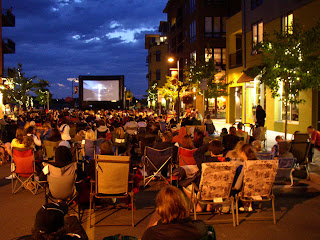Ten Routes for Community Film Distribution
 |
| Open Air Cinema |
1. How Content and Style determine the Target Group
It is alleged that very few community film makers start out with a clear sense of how their finished film will be distributed. This is the vexed question of the target audience. It also brings into play questions about the content of the film – the product – and whether it is fit for purpose in terms of its spectators. That means that the distribution agenda should always already be built into your production and planning process.
There’s clearly no point filming disturbing adult scenes that will be unusable for a target group of children. And will people really sit through a two hour community film on any topic, unless they were major participants throughout? Is your film relevant to a wider community, and how can you get it out there?
Here are some options to think about:
Evaluating Distribution Options
2. Broadcasters: TV, Cable and Satellite (including Free-View Services).
Apart from specialist community channels, public broadcasting and regional or local TV it is quite difficult to get a full-length documentary of 10 mins or more broadcast. That said, a rough cut of your film might be enough to gain funding or a commission for a more ambitious project. In the
3. On line opportunities.
There are many opportunities to make your film available globally through distribution sites such as YouTube and Vimeo. Also check out web tv channels and the broader training opportunities that they provide locally. ChewTV is a good example of a regional provider. Don’t forget that you can also send a microfilm to a mobile – excellent for bite sized community films that could have a viral impact. Caution: always check that your participants gave full permission for footage to be used for wider global dissemination. Ensure that you have not provided opportunities for people to poke fun at your valued contributors.
4. Private Screenings.
These tend to be for smaller groups of invited people. Private screenings are very good for special screenings where you are trying to reach and have an impact on decision-makers. Ensure that you provide enough time for discussion after your screening. If you have the resources it’s a good idea to provide additional information such as a press or media pack. It is possible that your film was intended from the outset only for a private screening, and the consent of the participants was based on that. Marginalised or stigmatised groups may be happy with this and only this outcome: a limited screening. But be sure to brief your participants on the reaction to the screening, or ask them to come along as advocates or witnesses. Real voices supporting virtual voices is a recipe for authentic engagement and social change.
5. DVD and Tape.
It’s now relatively inexpensive to duplicate your film on a dvd. But remember that there is an environmental and resource cost for design and printing, and for postage and packaging. If you really think that there is a for-sale market then dvds are a good solution. Think about how much people will really want to pay, and be honest about your costs in terms of time and money. A DVD short run always makes sense as an archival record for the participants and as a glossy product for the funders to exhibit to their colleagues to justify their investment in you. But is a trophy what you really want?!
6. Public or Community Screenings.
These are perhaps the primary target for your community film, and an opportunity to invite friends of the participants, their families, the local community, funders and local decision-makers. Ask someone to introduce your film briefly and leave time after the film for formal and/or informal discussion and debate. If you can film the audience’s reactions you will have further evidence that will contribute to your community project. Think carefully about the timing (day/evening) and the location. Will the community film be screening across a target group of homes, or will you use a mobile van? If you are screening in a village hall, will your film be integrated with an existing group, meeting, or event? Will you be joining up with a themed film festival? Why not check out the International Community Film Forum ? Or Media Matters ?
7. Social Media.
Do not miss the opportunity to align your video with your website, blog, and twitter accounts. These will provide a context for the community film and also an opportunity for people to respond to your film. Dialogue and debate will help to build a community around your film. The combination of social media and digital distribution is now very common, powerful and effective. This route may be the beginning of a long journey to start making money, or just getting noticed.
8. Engagement. Participants are your best co-distributors.
The product should make sense to its target audience. It should be on a level with them – not talking down to them. If children are involved in making the film – as they should be in a genuine participatory project – then you will be less likely to fall into the ‘unsuitability’ trap if the film is aimed at children. Similarly, your evidence must make sense; it must be pitched at the right level. By all means interview an academic or a nuclear physicist or and SEO Consultant. But ensure that the answers are presented in an intelligible fashion, avoiding jargon and private languages! Your aim is to include, include, include. Use clarification if necessary: ‘So you’re saying that …’ Your participants are the best form of quality control in this regard, and they will be able to tell you who they think should be a priority for viewing the film. A youth participant will keep you alert to youth relevance. Please add any comments below.
9. Film Societies
In Britain British Federation of Film Societies is the national organisation for the development and support of the film society and community cinema movement in the UK. They offer a wide range of services and resources dedicated to the needs of community cinemas. See also the International Federation of Film Societies.
10. Crowdfunding
"The crowd funding approach has long precedents in the sphere of charity. It is receiving renewed attention from both traditional and social entrepreneurs now that social media, online communities and micropayment technology make it straightforward to engage and secure donations or soon, investments, from a group of potentially interested supporters at very low cost." [Wikipedia]
The product should make sense to its target audience. It should be on a level with them – not talking down to them. If children are involved in making the film – as they should be in a genuine participatory project – then you will be less likely to fall into the ‘unsuitability’ trap if the film is aimed at children. Similarly, your evidence must make sense; it must be pitched at the right level. By all means interview an academic or a nuclear physicist or and SEO Consultant. But ensure that the answers are presented in an intelligible fashion, avoiding jargon and private languages! Your aim is to include, include, include. Use clarification if necessary: ‘So you’re saying that …’ Your participants are the best form of quality control in this regard, and they will be able to tell you who they think should be a priority for viewing the film. A youth participant will keep you alert to youth relevance. Please add any comments below.
9. Film Societies
In Britain British Federation of Film Societies is the national organisation for the development and support of the film society and community cinema movement in the UK. They offer a wide range of services and resources dedicated to the needs of community cinemas. See also the International Federation of Film Societies.
10. Crowdfunding
"The crowd funding approach has long precedents in the sphere of charity. It is receiving renewed attention from both traditional and social entrepreneurs now that social media, online communities and micropayment technology make it straightforward to engage and secure donations or soon, investments, from a group of potentially interested supporters at very low cost." [Wikipedia]
 |
| Can you Imagine a Different World ? |

Did you find this information heplful?
ReplyDeleteDid the ideas make sense?
How would you improve it?
Your opinions are highly valued and will assist me to improve my work - for the benefit of others too. Thanks.
Follow this blog and related themes on twitter:
ReplyDeletehttps://twitter.com/#!/PostFilm
Excellent Ian...
ReplyDeleteWe have already been trying few of the Reach out Alternatives as suggested by you...
** Community Screenings
** Private Screenings
** DVDs duplication and distribution
** Festival participation
We are yet to explore the online opportunities/Community Funding options.